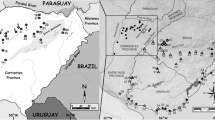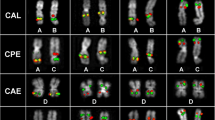Abstract
Seven species of the family Cercopithecidae have been studied using highresolution banding techniques. Comparative studies allowed us to identify the main chromosomal reorganizations in this group, as well as to establish the phylogenetic relationships between species. Some of the regions involved in evolutionary rearrangements correspond to human fragile sites and/or chromosomal rearrangements related to neoplasia.
Similar content being viewed by others
References
Barrios, L. (1987).Estudis Citogenètics pre i post Tractament en Pacients Afectats de Càncer, Tesi doctoral, Facultat de Ciències, Universitat Autònoma de Barcelona. Barcelona.
Bauchinger, M., and Götz, G. (1979). Distribution of radiation induced lesions in human chromosomes and dose-effect relation analysed with G-bading.Rad. Environ. Biophys. 16: 335–366.
Berger, R., Bloomfield, C. D., and Sutherland, G. R. (1985). Report of the Commitee on Chromosome Rearrangements in Neoplasia and on Fragile Sites (Human Gene Mapping 8, Helsinki Conference).Cytogenet. Cell Genet. 40: 490–535.
Buckton, K. E. (1983). Chromosome aberrations in patients treated with X-irradiation for Ankylosing Spondylitis. In Ishihara, T., and Sasaki, M. (Eds.),Radiation Induced Chromosome Damage in Man, Alan R. Liss, New York, pp. 491–511.
Caballín, M. R., Miró, R., Ponsà, M., Florit, F., Massa, C., and Egozcue, J. (1980). Banding patterns of the chromosomes ofCercopithecus petaurista (Schreber, 1975): Comparison with other primate species.Folia primatol. 34: 278–285.
Camargo, M., and Cervenka, J. (1980). Pattern of chromosomal replication in synchronized lymphocytes. I. Evaluation and application of methotrexate block.Hum. Genet. 54: 47–53.
Clemente, I. C., Garcia, M., Ponsà, M., and Egozcue, J. (1987). High resolution chromosome banding inCebus apella, Cebus albifrons, andLagothrix lagothricha: Comparison with the human karyotype.Am. J. Primatol. 13: 23–36.
Dutrillaux, B. (1975). Comparison du caryotype de l'orangoutang (Pongo pygmaeus) a celui de l'homme, du chimpanzée et du gorille.Ann. Genet. 18: 153–161.
Dutrillaux, B. (1979). Chromosomal evolution in primates: Tentative phylogeny fromMicrocebus murinus (Prosimian) to man.Hum. Genet. 48: 251–314.
Dutrillaux, B., Biemont, M. C., Viegas-Pequignot, E., and Laurent, C. (1979a). Comparison of the karyotypes of four CercopithecidaePapio papio, P. anubis, Macaca mulatta andM. fascicularis.Cytogenet. Cell Genet. 23: 77–83.
Dutrillaux, B., Fosse, A. M., and Chauvier, G. (1979b). Etude cytogénétique de 6 espèces de Mangabeys (Papiinae, Cercopithecidae).Ann. Genet. 22: 88–92.
Dutrillaux, B., Couturier, J., and Chauvier, G. (1980). Chromosomal evolution, of 19 species or sub-species of Cercopithecidae.Ann. Genet. 23: 133–143.
Dutrillaux, B., Couturier, J., Muleris, M., Lombard, M., and Chauvier, G. (1982). Chromosomal phylogeny of forty-two species or sub-species of cercopithecoids (Primates, Catarrhini).Ann. Genet. 25: 96–109.
Dutrillaux, B., Viegas-Pequignot, E., Mouthuy, M., Antoine, J. L., Prod'Homme, B. and Sportes, M. (1983). Tentative estimate from the study of radiation-induced translocations in human fibroblasts.Mutat. Res. 119: 343–350.
Dutrillaux, B., Prieur, M., and Aurias, A. (1986a). Theoretical study of inversions affecting human chromosomes.Ann. Genet. 29: 184–188.
Dutrillaux, B., Sabatier, L., Al Achkar, W., Muleris, M., Aurias, A., Couturier, J., Dutrillaux, A. M., Gerbault-Seureau, M., Hoffschir, F., Lamoliatte, E., Lefrancois, D., Lombard, M., Marlhen, F., Prieur, M., Prod'Homme, M., Viegas-Pequignot, E., and Volobovev, V. (1986b). Radiation induced inversions in human somatic cells.Ann. Genet. 29: 189–194.
Estop, A. M., Garver, J. J., and Pearson, P. L. (1978a). Further studies on the comparative karyology of the African green and Rhesus monkeys.Genetica 49: 131–138.
Estop, A. M., Garver, J. J., Pearson, P. L., Dijksman, T. M., Wijnen, L., and Meera Khan, P. (1978b). Gene assignments to the presumptive homologs, of human chromosomes 3, 4, 5, 7, 8, 10, 18, 19 and 21 in the Pongidae and Cercopithecoidea.Cytogenet. Cell Genet. 22: 558–563.
Fryns, J. P., Kieczkowska, A., and Van den Berghe, H. (1986). Paracentric inversions in man.Hum. Genet. 73: 205–213.
Gallimore, P. M., and Richardson, C. R. (1973). An improved banding technique examplified in the karyotype analysis of two strains of rat.Chromosoma 41: 259–263.
Garcia, M., Miró, R., Ponsà, M., and Egozcue, J. (1983). Constitutive heterochromatin polymorphism inLagothrix lagothricha cana, Cebus apella andCebus capucinus.Am. J. Primatol. 4: 117–126.
Garver, J. J., Pearson, P. L., Estop, A., Dijksman, T. M., Wijnen, L. M. M., Westerveld, A., and Meera Khan, P. (1978). Gene assignments, to the presumptive homologs, of human chromosomes 1, 6, 11, 12 and X in the Pongidae and Cercopithecoidea.Cytogenet. Cell Genet. 22: 564–569.
Guichaoua, M., Mattei, M. G., Mattei, J. F., and Giraud, F. (1982). Aspects génétiques des sites fragiles autosomiques. A propos de 40 cas.J. Genet. Hum. 30: 183–197.
Heim, S., and Mitelman, F. (1987). Nineteen of 26 cellular oncogenes precisely localized in the human, genome map to one of the 83 bands involved in primary cancer-specific rearrangements.Hum. Genet. 75: 70–72.
Hecht, F., and Sutherland, G. R. (1984). Fragile sites and cancer breakpoints.Cancer Genet. Cytogenet. 12: 179–181.
Holmquist, G., and Dancis, B. M. (1980). A general model of karyotype evolution.Genetica 52/53: 151–163.
Jotterand-Bellomo, M. (1984). Les sites fragiles autosomiques.J. Genet. Hum. 32: 155–166.
Kaiser, P. (1984). Pericentric inversions.Hum. Genet. 68: 1–47.
Lalley, P. A. O'Brein, S. J., Créau-Goldberg, N., Davisson, M. T., Roderick, T. H., Echard, G., Womack, J. E., Graves, J. M., Doolittle, D. P., and Guidi, J. N. (1987). Report of the Committee on Comparative Mapping.Cytogenet. Cell Genet. 46(1–4): 367–389.
LeBeau, M. M., and Rowley, D. (1984). Heritable fragile sites and cancer.Nature 308: 607–608.
Lee, C. L. Y., and Kamra, O. (1981). The pattern of radiation-induced transmissible aberrations in a human cell culture.Hum. Genet. 57: 380–384.
Miró, R. (1981).Aplicación de las Técnicas de Bandas Cromosómicas al Estudio de la Distribuciòn de la Heterocromatina en Primates, Tesi doctoral, Facultat de Ciencies, Universitat Autònoma de Barcelona, Barcelona.
Miró, R., Clemente, I. C., Caballín, M. R., Estop, A. M., Garcia, M., Ponsà, M., Fuster, C., Genescà, A., and Egozcue, J. (1986). Aplicación de las técnicas de bandas de alta resolución al estudio de la evolución cromosómica en Primates. InSerie Memorias de Eventos Cientificos Colombianos ICFES Bogotá, Colombia, Vol. 43, pp. 111–118.
Miró, R., Clemente, I. C., Fuster, C., and Egozcue, J. (1987). Fragile sites, chromosome evolution, and human neoplasia.Hum. Genet. 75: 345–349.
Muleris, M., Paravatou-Petsota, M., and Dutrillaux, B. (1984). Diagrammatic representation for chromosomal mutagenesis studies. II. Radiation-induced rearrangements inMacaca fascicularis.Mutat. Res. 126: 93–103.
Muleris, M., Couturier, J., and Dutrillaux, B. (1986). Phylogénie chromosomique des Cercopithecoidea.Mammalia 50: 38–58.
Pearson, P. L., and Roderick, T. H. (1978). Report of the Committee on Comparative Mapping.Cytogenet. Cell Genet. 22: 150–162.
Pearson, P. L., Garver, J. J., Estop, A. M., Dijksman, T. M., Wijnen, L. M. M., and Meera Khan, P. (1978). Gene assignments to the presumptive homologs of human chromosomes 2, 9, 13, 14 and 15 in the Pongidae and Cercopithecoidea.Cytogenet. Cell Genet. 22: 588–593.
Pearson, P. L., Roderick, T. H., Davisson, H. T., Garver, J. J., Warburton, D., Lalley, P. A., and O'Brien, S. J. (1979). Report of the Committee on Comparative Gene Mapping.Cytogenet. Cell Genet. 25: 82–95.
Pearson, P. L., Roderick, T. H., Davisson, H. T., Lalley, P. A., and O'Brien, S. J. (1982). Report of the Committee on Comparative Gene Mapping.Cytogenet. Cell Genet. 32: 208–220.
Ponsà, M., and Egozcue, J. (1981). Cytogenetic studies in the speciesCercopithecus pogonias (Bennet, 1833) andCercopithecus nictitans (Linnaeus 1766).Int. J. Primatol. 2: 263–271.
Ponsà, M., Estop, A. M., Miró, R., Rubio, A., and Egozcue, J. (1980). Banding patterns of the chromosomes ofMiopithecus talapoin compared withMacaca mulatta andCercopithecus aethiops.Cytogenet. Cell Genet. 28: 41–46.
Ponsà, M., Miró, R., Estop, A. M., and Egozcue, J. (1981). Banding patterns of the chromosomes ofErythrocebus patas (Schreber 1774) comparated to other primate species.Genetica 56: 39–46.
Ponsà, M., Estop, A. M., Egozcue J., Garcia, M. and Miró, R. (1986). Comparative chromosome banding studies in the Family Cercopithecidae.Hum. Evol. 6: 525–533.
Raoul, O. (1970).Contribution a l'Étude des Lacunes s'Accompagnant d'Endoréduplications Sélectives de Certains Chromosomes Humains, Thèse médicine, Paris.
Sineo, L., Stanyon, R., and Chiarelli, B. (1986). Chromosomes of theCercopithecus aethiops (Linnaeus, 1758),C. cynosurus (Scopoli, 1786),C. pygerythus (Cuvier, 1821) andC. sabaeus (Linnaeus, 1758).Int. J. Primatol. 7: 569–582.
Summer, A. T. (1972). A simple technique for demonstrating centromeric heterochromatin.Exp. Cell Res. 75: 304–306.
Tanaka, K., Kamada, N., Ohkita, T., and Kuramoto, A. (1983). Non-random distribution of chromosome breaks in lymphocytes of atomic bomb survivors.J. Radiat. Res. 24: 291–304.
Viegas-Pequignot, E., and Dutrillaux, B. (1978). Une méthode simple pour obtenir des prophases et des prometaphases.Ann. Genet. 21: 122–125.
Yunis, J. J., and Prakash, O. (1982). The origin of man: A chromosomal pictorial legacy.Science 215: 1525–1530.
Yunis, J. J., and Soreng, A. L. (1984). Constitutive fragile sites and cancer.Science 226: 1199–1204.
Author information
Authors and Affiliations
Rights and permissions
About this article
Cite this article
Clemente, I.C., Ponsà, M., Garcia, M. et al. Chromosome evolution in the cercopithecidae and its relationship to human fragile sites and neoplasia. International Journal of Primatology 11, 377–398 (1990). https://doi.org/10.1007/BF02193007
Received:
Revised:
Issue Date:
DOI: https://doi.org/10.1007/BF02193007




